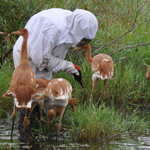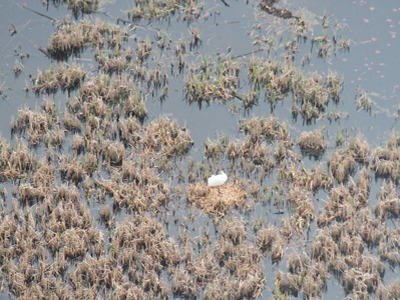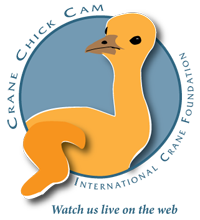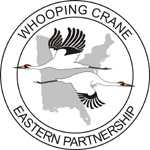| Media Contact: Joan Garland, ICF Outreach Coordinator, 608-381-1262 The Whooping Crane Eastern Partnership (WCEP), an international coalition of public and private groups that is reintroducing Whooping Cranes to eastern North America, is pleased to report that last year’s “Class of 2011” Whooping Cranes have all begun their spring migration north. On April 12, nine Whooping Cranes that were led south by WCEP partner Operation Migration’s ultralight aircraft, began their unassisted migration from Wheeler National Wildlife Refuge (NWR) in Decatur, Ala. The juvenile cranes are currently located in Wayne County, Ill. A 10th Whooping Crane, which broke off from the ultralight-led migration last fall, has already completed her migration back to Wisconsin. In addition to the nine ultralight-led birds, eight juvenile Whooping Cranes are making their first northward migration this spring as part of WCEP’s Direct Autumn Release (DAR) program. In the fall, biologists from the International Crane Foundation released the cranes in the company of older cranes at Horicon NWR in Dodge County, Wis. The young birds learned the migration route by following the older cranes. This spring, four of the DAR juvenile cranes have completed their migration back to Wisconsin. Two DAR cranes are in Dubois County, Ind.; one was reported in Fayette County, Ill. on March 26; and one has not been seen since leaving on fall migration. “The Wisconsin Department of Natural Resources (DNR) is excited about the news of the return of last year’s chicks back to Wisconsin. We will continue to follow their progress closely and hope that the birds eventually return to their release grounds in east-central Wisconsin,” said Cathy Stepp, Wisconsin DNR Secretary. “As part of these efforts, the Wisconsin DNR is also looking forward to the second year of releases at White River Marsh State Wildlife Area and Horicon NWR.” Thanks to the efforts of WCEP, there are now 106 Whooping Cranes in the wild in eastern North America, which was part of their historic range. Most of these Whooping Cranes have completed their spring migration. Of the cranes that have returned to Wisconsin, 13 pairs have initiated nests and eight nests are still active (below, photo by ICF staff). Five of the nests are located on Necedah NWR, and three nests are located off the refuge.
Whooping Cranes were on the verge of extinction in the 1940s. Today, there are only about 600 birds in existence, approximately 445 of them in the wild. Aside from the 106 WCEP birds, the only other migrating population of Whooping Cranes nests at Wood Buffalo National Park in northern Alberta, Canada and winters at Aransas NWR on the Texas Gulf Coast. A non-migrating flock of approximately 20 birds lives year-round in the central Florida Kissimmee region, and an additional 17 non-migratory cranes live in southern Louisiana. WCEP asks anyone who encounters a Whooping Crane in the wild to please give them the respect and distance they need. Do not approach birds on foot within 200 yards; remain in your vehicle; do not approach in a vehicle any closer than 100 yards. Also, please remain concealed and do not speak loudly enough that the birds can hear you. Finally, do not trespass on private property in an attempt to view or photograph Whooping Cranes. Whooping Crane Eastern Partnership founding members are the International Crane Foundation, Operation Migration, Inc., Wisconsin Department of Natural Resources, U.S. Fish and Wildlife Service, the U.S. Geological Survey’s Patuxent Wildlife Research Center and National Wildlife Health Center, the National Fish and Wildlife Foundation, the Natural Resources Foundation of Wisconsin, and the International Whooping Crane Recovery Team. Many other flyway states, provinces, private individuals and conservation groups have joined forces with and support WCEP by donating resources, funding and personnel. More than 60 percent of the project’s budget comes from private sources in the form of grants, public donations and corporate sponsors. |   Learn more Learn moreabout ICF’s “Five Steps to Save Whooping Cranes” and follow our Whooping Crane Updates on our website and on Facebook.
Share this video with your friends and help us spread the word that disturbing, harassing or killing Whooping Cranes is a crime.
Make a gift to support Whooping Crane conservation. |




